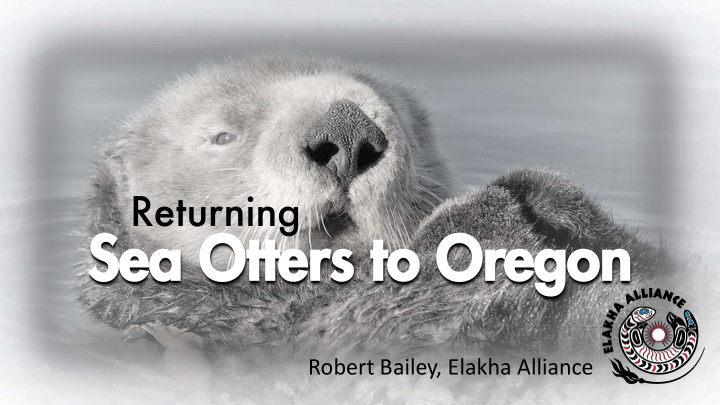



Returning Sea Otters to Oregon Robert Bailey, Elakha Alliance
Once, They W Once, The y Were ere Here. Here. • Once contiguous population between Northern Japan and Baja California. • ~300,000 animals. • China Fur Trade 1741 – 1850 killed all but a few remnant populations.
Populations Populations today today 800-mile gap Sea otters present Sea otters absent
We ca e care re becaus because e Sea otters Sea otters are a are a keystone keystone species species An ecosystem engineer With disproportionate influence beyond immediate food & space; influences ecosystem structure & function.
Sea otters Sea otters promote promote ecosystem ecosystem health. health. Sea otters present …… sea otters absent
Sea ott Sea otters ers benefit es benefit estuaries, tuaries, too. too. When sea otters are present: • Improved water quality • Increased biological productivity • Habitat for salmon smolts, other juvenile fish
Sea otters Sea otters help help fight fight climate climate change. change. Pounds of Carbon Stored/Acre* With kelp: 1,867 lbs/acre Photo: Jackie Hildering Without kelp: 21 lbs/acre * Wilmers et al (2012) Frontiers in Ecology & Environment Photo: Annie Crawley
Witho Without ut sea otters, ur sea otters, urchins chins are att are attacking acking Oregon’s kelp forests. Port Orford: Same spot August 2018 June 2016 Photos courtesy of Dr. Leigh Torres, OSU Marine Mammal Institute
Benefits from restoration: Benefits from restoration: Ecological benefits: • More biological productivity in nearshore ocean and coastal estuaries; • More complex, resilient food webs; • More eggs, larvae retained; • More habitat, food for 20+ species of fish; • Increased substrate for herring spawn, invertebrate grazers; • Shelter for juvenile salmon, rockfish. Photo by Alex Mustard
Benefits Benefits from restoration: from restoration: Cultural/Economic benefits • Restored connection between sea otters and coastal Indian tribes; • Improved habitat for commercial and recreational fish species; • Increased ecosystem resilience supporting all marine life; • Economic boon: tourism, wildlife viewing. (Gregr, et al study June 2020)
Potential Potential negatives negatives from restoration from restoration Possible conflicts • Local competition with commercial harvest of Dungeness crab, red urchins; • Local competition with recreational crabbers and clam diggers.
Abou About the t the Elakha Elakha Alliance Alliance
Elakha Alliance: Elakha Alliance: • An Oregon non-profit begun in early 2000 by Dave Hatch, member of the Confederated Tribes of Siletz Indians. • Formally organized in 2018. • Approved 501(c)(3) non-profit status from IRS. • Oregon Wildlife Foundation is fiscal sponsor.
Elakha Alliance: Elakha Alliance: Our Mission: To restore a healthy population of sea otters to the Oregon coast and, in the process, help make Oregon’s marine ecosystem more robust and resilient.
What w What we e are are doing doing: 2020 - 2021: • Begun work on a science-based Feasibility Study (USFWS funding) - Public draft by end of January, 2021 -- Final by end of September 2021; • Dr. Tim Tinker is lead author; • 12-member Scientific & Technical Advisory Committee.
What w What we e are are doing doing: 2020 - 2021: • Connecting with people and organizations about our mission (funding from Meyer Memorial Trust). Mid-Coast Watershed Council Saltwater Sportsman Show
What w What we e are are doing doing: 2020 - 2021: • Using our website and social media to connect with people about our mission (funding from Meyer Memorial Trust).
What w What we plan e plan to d to do: o: 2020 - 2021: • Complete an Economic Impact Assessment (funding pending, USMCC); • Assist Confederated Tribes of Siletz Indians to submit a proposal to USFWS TWG to assess existing habitat/prey information and identify research priorities; coordinate with ODFW, OSU and others; • Engage with community efforts in Port Orford to address loss of kelp; • Hold a scientific Status of Knowledge Symposium in October 2021; • Build long-term strategic relationships.
bob@elakhaalliance.org www.elakhaalliance.org
next: legal and administrative framework for restoration 2020
Recommend
More recommend